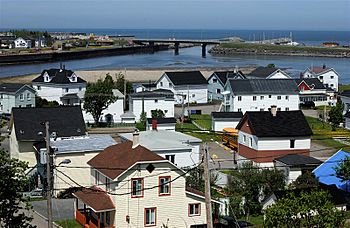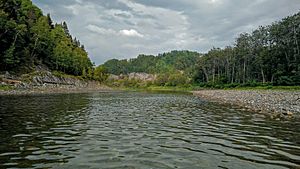Matane River facts for kids
Quick facts for kids Matane River |
|
|---|---|

Mouth of the Matane River
|
|
| Country | Canada |
| Province | Quebec |
| Region | Bas-Saint-Laurent |
| MRC | La Matanie Regional County Municipality |
| Physical characteristics | |
| Main source | streams on the western slope of Mont Blanc Rivière-Bonjour (canton Le Clercq) 350 m (1,150 ft) 48°47′08″N 66°52′57″W / 48.78556°N 66.88250°W |
| River mouth | Saint Lawrence River Matane 1 m (3.3 ft) 48°51′11″N 67°32′01″W / 48.85306°N 67.53361°W |
| Length | 105.3 km (65.4 mi) |
| Basin features | |
| Tributaries |
|
The Matane River is a cool river in Quebec, Canada. It flows through the La Matanie Regional County Municipality in the Bas-Saint-Laurent region. This river is located on the Gaspé Peninsula. It finally empties into the big Saint Lawrence River at the city of Matane.
The Matane River flows through several areas. These include the unorganized territory of Rivière-Bonjour, and the towns of Saint-René-de-Matane, Saint-Alexis-de-Matapédia, Saint-Léandre, and the city of Matane.
Contents
River's Journey: Where the Matane River Flows
The Matane River starts from mountain streams. These streams are found on the western side of Mont Blanc. This area is part of the Matane Wildlife Reserve. The river's source is about 0.5 kilometers north of Mont Blanc's peak. It is also about 40 kilometers from where the Matane River meets the Saint Lawrence River.
The Matane River flows for about 105.3 kilometers. Its journey can be divided into three main parts:
Upper Course: Starting High Up
The first part of the river's journey is about 30 kilometers long. Here, the river flows mostly towards the west. It drops quite a bit in height, from 955 meters down to 318 meters. Along this part, the river collects water from smaller streams like the Dontigny stream and Camp stream. It also passes through a heart-shaped lake called Lac de la Tête. Further along, it crosses Lac Matane, which is about 220 meters above sea level. This section ends at a dam on Lac Matane.
Middle Course: Rapids and Tributaries
From the dam at Lac Matane, the river flows for about 33.9 kilometers. In this section, the Matane River flows southwest. It goes over several waterfalls and rapids, making it an exciting part of the river. It also passes under a few road bridges.
Many smaller rivers and streams join the Matane River here. These include the rivière à la Truite, Pitounes stream, and Simonneau stream. The river then turns northwest and west, collecting water from other streams like the Saint-Jean stream. This part of the river ends where the Tamagodi River joins it from the south.
Lower Course: Towards the Saint Lawrence River
The final part of the Matane River's journey is about 41.4 kilometers long. After the Tamagodi River joins, the Matane River flows northwest. It passes through the hamlet of Rivière-Matane and under Route 195.
Further downstream, it flows past the village of Saint-René-de-Matane and under its covered bridge. The Petite rivière Matane and the Bastien stream are some of the waterways that join the Matane River in this section. The Petchedetz River also flows into the Matane River here.
As it gets closer to the city of Matane, the river passes under several bridges. It also flows around the Crust Islands. Finally, the Matane River flows into the Saint Lawrence River at the city of Matane.
What's in a Name? The Meaning of "Matane"
The name "Matane" was first used by Samuel de Champlain in 1603. He called the river "Mantanne." Historians have different ideas about where the name comes from. Here are four popular theories:
- Beaver Pool: Many believe the name comes from the Micmac language word mtctan. This word means "beaver pool." This makes sense because the area used to have many beavers.
- Spine: Another idea is that it comes from a Maliseet word meaning "spine." This might describe how the river winds through the hills of the Gaspé region.
- Wreck or Debris: Some think it comes from the Algonquin word matandipives. This means "wreck" or "debris from a ship." This could refer to the strong currents at the river's mouth. These currents might have made it hard for ships to navigate.
- Meeting of the Waters: A fourth theory suggests the name comes from "mattawa" or "matawin." These words mean "meeting of the waters."
Salmon: A Special Fish in the Matane River
The Matane River is very famous for its Atlantic salmon. People come from all over to fish for these amazing fish. This type of fishing is called sport fishing.
Fishing Rules and Conservation
Fishing for salmon on the Matane River is very controlled. You can only use fly fishing, which is a special way of fishing with a lightweight lure. To fish, you need to buy a daily permit. You also need a fishing license from the province of Quebec. These strict rules help protect the salmon and keep their numbers healthy. You can get salmon permits from the ZEC office in Matane.
The river flows through a beautiful valley. You can see a covered bridge, small farms, and charming villages along Route 132.
There are over 70 famous salmon pools along the river. These are popular spots for fishing during the summer. Two well-known salmon flies, the Tiger Ghost and the Matane Special, were created here. They are still used by local fishers.
Salmon Reproduction and Observation
A large part of the upper river and its source areas are protected. This helps keep the environment safe for the salmon. The Matane River is a very important place for Atlantic salmon to lay their eggs.
There is a special fish ladder at the Mathieu-D'Amours dam in Matane. This ladder helps salmon swim upstream past the dam to reach their spawning grounds. There's also an observation center where you can watch the salmon as they migrate. It's a great way to see these powerful fish up close!


